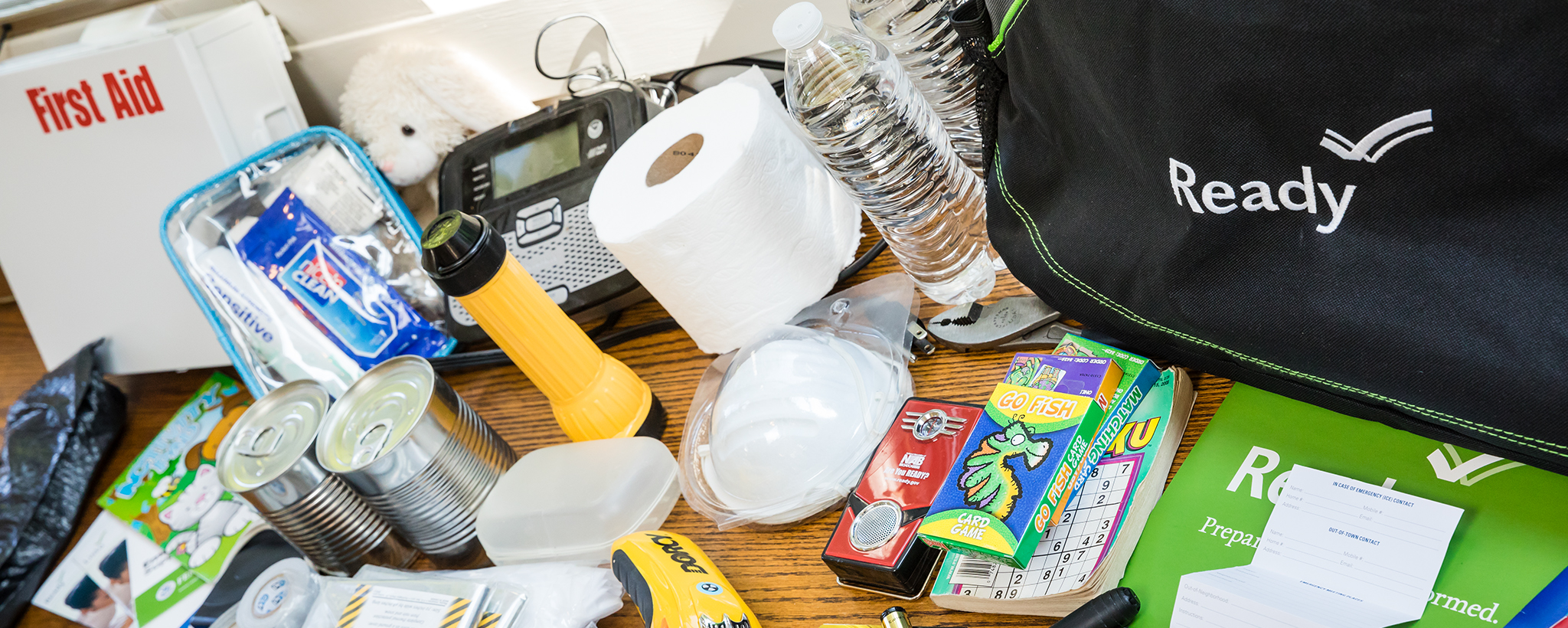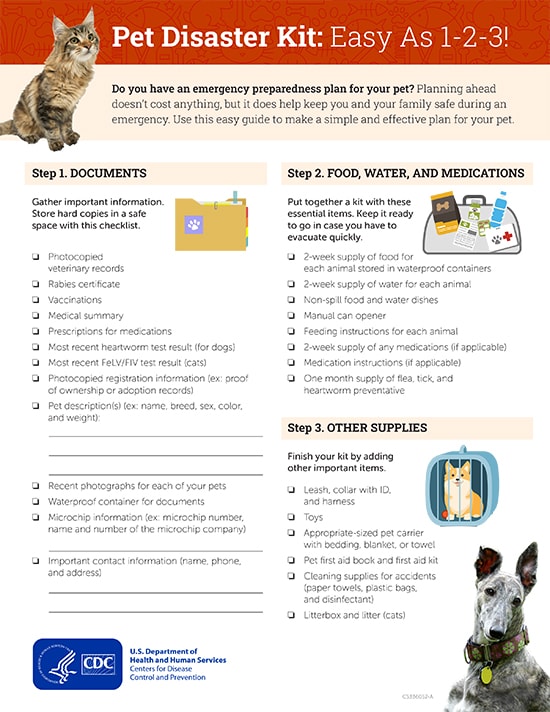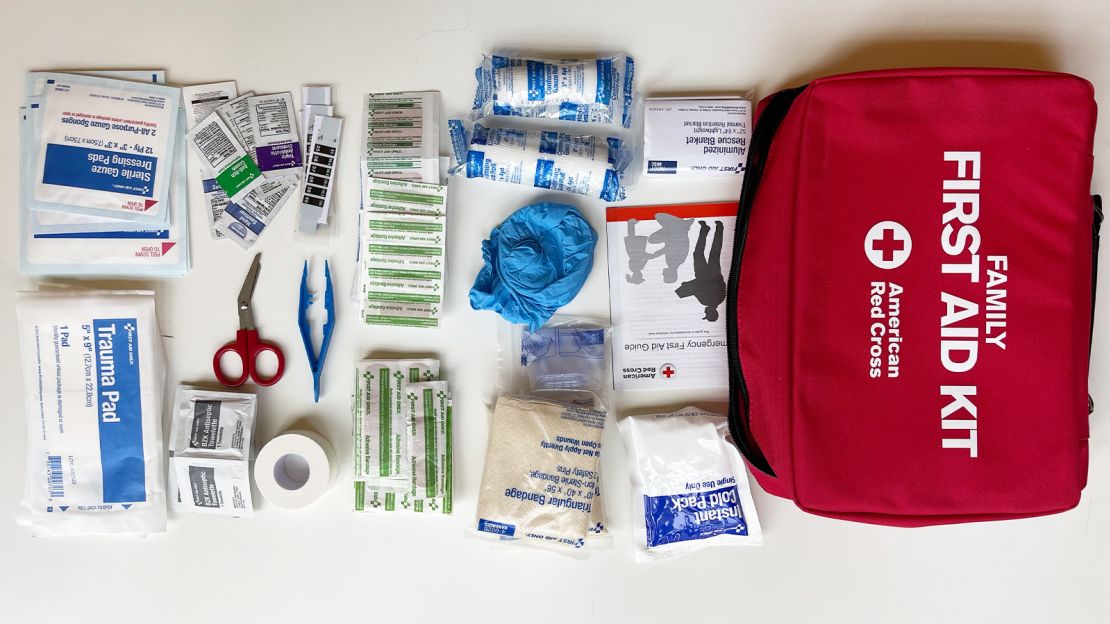A pet first aid kit should include gauze, adhesive tape, hydrogen peroxide, scissors, and tweezers. These essential items will help you quickly address injuries or emergencies for your pet.
When accidents happen, having a well-prepared first aid kit can make a significant difference in providing immediate care and preventing further complications. Whether at home or on the go, ensuring you have the necessary supplies readily available can be crucial for your pet’s well-being.
By assembling a pet first aid kit with the right items, you can be better prepared to handle unexpected situations and ensure the safety and health of your beloved companion. It’s important to be proactive and have these essential supplies on hand, so you can act swiftly if your pet requires immediate attention.

Credit: www.ready.gov
Why Every Pet Owner Should Have A First Aid Kit
As a responsible pet owner, it’s crucial to be prepared for any medical emergencies that may arise with your furry companions. Having a pet first aid kit at your disposal can be a literal lifesaver in critical situations. Whether it’s a minor injury or a major health issue, having the necessary supplies can make all the difference in providing immediate care to your pets. Here’s why every pet owner should have a first aid kit:
Protecting Your Pet In Emergencies
Pet emergencies can happen when you least expect them, and having a well-equipped first aid kit can help protect your pet’s health and well-being. Timely intervention during critical situations such as accidents or sudden illnesses can make a significant difference in the outcome, and a first aid kit ensures that you have the tools needed to address these emergencies promptly.
Being Prepared For Common Pet Injuries
Pets are prone to a variety of common injuries, such as cuts, scrapes, burns, and insect bites. Having a first aid kit allows you to be prepared for these eventualities, providing the ability to address the injury before seeking professional veterinary care. Being prepared for these common pet injuries helps in providing immediate relief and preventing the situation from worsening.
The Basic Essentials
When it comes to pet first aid, having the right supplies on hand can make the difference in a moment of crisis. Putting together a pet first aid kit is essential for every pet owner. Here, we will discuss the basic essentials that should be included in your pet first aid kit.
Antiseptic Solution
An antiseptic solution such as povidone-iodine or chlorhexidine is crucial for cleaning wounds and preventing infection. It’s important to have this as part of your pet first aid kit to ensure proper wound care for your furry friend.
Gauze Pads
Including sterile gauze pads in your pet first aid kit is vital for cleaning and dressing wounds. Gauze pads help to absorb blood and exudate from a wound and can easily be secured in place with adhesive tape.
Adhesive Tape
Adhesive tape is an important item for securing dressings and bandages. Having medical tape in your pet first aid kit can help to preserve the cleanliness and integrity of a wound as it heals.
Digital Thermometer
A digital thermometer is a key tool for monitoring your pet’s health. It can help you determine if your pet is running a fever, which can indicate an underlying health issue. Including a digital thermometer in your pet first aid kit is crucial for assessing your pet’s condition in an emergency.
Tweezers
Tweezers are useful for removing splinters, ticks, and other foreign objects that may become embedded in your pet’s skin or fur. Including a pair of tweezers in your pet first aid kit is essential for addressing minor injuries and preventing further complications.
Medications And Ointments
Find the essential medications and ointments for your pet first aid kit. Keep them handy for any emergencies that may arise.
Antihistamines
Antihistamines are a crucial component of a comprehensive pet first aid kit. These medications are used to relieve allergy symptoms and can be a lifesaver if your furry friend experiences an allergic reaction. When selecting antihistamines for your kit, make sure to choose a brand that is safe for pets and consult your veterinarian for appropriate dosages. In case of insect bites, hives, or other allergic reactions, giving your pet an antihistamine can provide immediate relief and prevent the reaction from worsening. Remember to always follow the instructions provided by your veterinarian and update your first aid kit as needed.Hydrogen Peroxide
Another essential item for your pet first aid kit is hydrogen peroxide. This common household item can be used to induce vomiting in emergency situations, such as when your pet ingests something toxic. However, it’s important to note that hydrogen peroxide should only be used under the guidance of a veterinarian, as inducing vomiting can sometimes be harmful depending on the substance ingested or the condition of the pet. When using hydrogen peroxide, always follow your veterinarian’s instructions and consult them immediately for proper guidance.Saline Solution
Saline solution is a versatile and handy addition to your pet first aid kit. It can be used to clean wounds, flush out foreign objects from your pet’s eyes, and soothe minor irritations. Saline solution is gentle and safe for pets, providing an effective way to remove debris or dirt from wounds without causing further harm. Keeping a bottle of saline solution in your kit ensures that you have a gentle and effective means of cleaning and caring for your pet’s injuries.Topical Antibiotic Ointment
Including a topical antibiotic ointment in your pet first aid kit is vital for preventing infection and promoting faster wound healing. This type of ointment helps create a protective barrier over minor cuts, scrapes, or burns, reducing the risk of bacterial contamination. Look for ointments specifically formulated for pets, as some human products may contain ingredients that are harmful to animals. Apply the ointment as directed by your veterinarian to keep your pet’s wounds clean and promote proper healing. Creating a pet first aid kit with these essential medications and ointments ensures that you are prepared for a wide range of minor medical emergencies. Remember to periodically check expiration dates and replace any items that have expired. Being proactive and having a well-stocked first aid kit can make all the difference in ensuring your pet’s safety and well-being in times of need.
Credit: www.cdc.gov
Additional Supplies
Aside from the essential items mentioned in the previous section, there are a few additional supplies that you should consider including in your pet first aid kit. These supplies can come in handy in various emergency situations and can make a significant difference in providing immediate care for your furry friend.
Gloves
Having a pair of gloves in your pet first aid kit is essential for maintaining cleanliness and preventing the spread of infections. Whether you need to clean a wound, give medication, or handle any bodily fluids, having gloves will protect both you and your pet. Make sure to choose gloves that are specifically designed for medical use and that fit you properly for maximum comfort.
Scissors
Scissors may seem like an unusual item to include in a pet first aid kit, but they can be incredibly useful in many situations. Whether you need to cut gauze or dressings to the required size, trim hair away from a wound, or carefully remove entangled fur, having a pair of sharp, stainless steel scissors is a must. Ensure they are properly sanitized and stored in a protective case to prevent any accidents.
Emergency Blanket
An emergency blanket is a lightweight, compact item that can provide much-needed warmth and comfort to your pet in case of an emergency. These blankets are designed to retain body heat and protect against extreme temperatures. Whether your pet is experiencing shock, low body temperature, or simply needs a cozy place to rest, an emergency blanket can help stabilize their condition until professional help arrives.
Syringes
Syringes are an important addition to your pet first aid kit, especially if you need to administer oral medications or liquids. They allow for accurate dosing and precise delivery, ensuring your pet receives the necessary treatment. Opt for syringes with clear markings and smooth operation to make the process as stress-free as possible for both you and your pet.
Sterile Eye Wash
Your pet’s eyes are sensitive and can be prone to irritation or injury. Having sterile eye wash specifically formulated for pets can be a lifesaver in cases of debris or other foreign substances getting into their eyes. It can also help soothe irritated eyes and ensure proper eye hygiene. Make sure to check the expiration date regularly and replace the eye wash solution when necessary.
Important Documentation
When creating a pet first aid kit, essential items include documentation such as medical records, vaccination certificates, and emergency contacts. These documents are important for providing vital information to veterinary professionals in case of an emergency. Being prepared with proper documentation can help ensure prompt and effective care for your beloved pet.
Contact Information
When it comes to creating a pet first aid kit, it’s crucial to include important documentation that can assist in emergencies. Contact information should be readily available in case you need to reach out for help or provide details to a veterinarian. Always start with the basics and include your name, phone number, and address. Additionally, include the contact information for your regular veterinarian and any emergency veterinary clinics in your area. This ensures that even in times of panic, you can quickly access the necessary numbers to seek assistance for your beloved pet.Medical Records
Including your pet’s medical records in their first aid kit is essential. This allows any veterinarian you encounter to have access to your pet’s history, which can be critical in diagnosing and treating any issues. These records should include vaccination records, previous surgeries, known allergies, and current medications. If your pet has any chronic conditions or ongoing treatments, make sure to include those details as well. By having all this information readily available, you can save valuable time and ensure proper care for your pet.Instructions For Administering Medications
In addition to medical records, your pet first aid kit should also have instructions for administering medications. This information is vital, especially if you have a pet with a pre-existing condition that requires regular medication or if they need medication in case of emergencies. Clearly detail the dosage, frequency, and method of administering each medication. If your pet takes medication in a specific manner, such as mixed with food or applied topically, include these instructions as well. This ensures that anyone caring for your pet in an emergency situation can provide the necessary treatment accurately and promptly. Whether you’re at home or on the go, having the right documentation in your pet first aid kit can make all the difference in an emergency situation. By including contact information, medical records, and instructions for administering medications, you’re better prepared to provide the best possible care for your beloved furry friend. Don’t forget to double-check and update these documents regularly to ensure they are accurate and up to date. With these important pieces in place, you can have peace of mind knowing that you’re ready to handle any pet emergency that comes your way.
Credit: www.cnn.com
Frequently Asked Questions Of Essential Items For Creating A Pet First Aid Kit
What Should Be In A Pet First Aid?
A pet first aid kit should include: gauze pads, adhesive tape, non-stick bandages, antiseptic wipes, cotton balls, tweezers, scissors, disposable gloves, saline solution, and a list of emergency numbers. Keep it in a portable container and easily accessible.
What Should Be In A Pet Emergency Kit?
A pet emergency kit should include items like first aid supplies, enough food and water for at least three days, important documents (vaccination records, identification), medications, a blanket or towel, a leash and collar, and toys or familiar items to comfort your pet.
How Do You Make A Dog First Aid Kit?
To create a dog first aid kit, gather essentials like bandages, gauze, adhesive tape, hydrogen peroxide, tweezers, and a pet thermometer. Also include antiseptic wipes, scissors, disposable gloves, a leash, and your veterinarian’s contact information. Keep the kit easily accessible in case of emergencies.
What Are The 7 Contents Of A First Aid Kit?
A standard first aid kit usually contains seven essential contents, namely adhesive bandages, antiseptic wipes, adhesive tape, non-latex gloves, sterile gauze pads, scissors, and tweezers.
Conclusion
To ensure the safety and well-being of our furry friends, it is vital to have a pet first aid kit stocked with essential items. From basic supplies like bandages and antiseptic wipes to specialized items such as tick removers and emergency contact information, a well-prepared kit can make all the difference in a pet emergency.
By taking the time to assemble a pet first aid kit, you are not only equipping yourself to handle unexpected situations, but also providing peace of mind knowing that you are ready to provide immediate care when needed. So don’t wait, start gathering the necessary items to create a pet first aid kit today!
